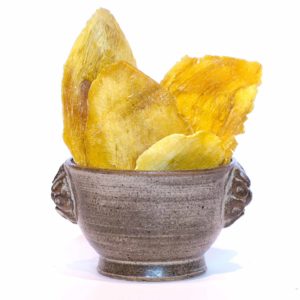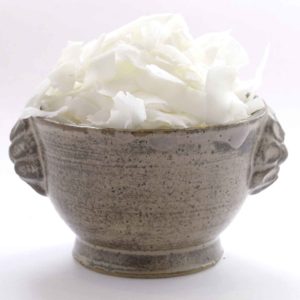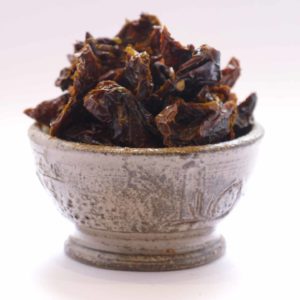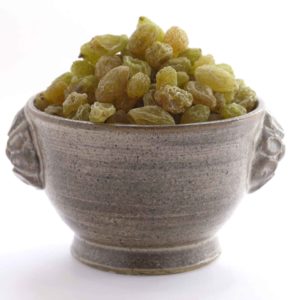0
- ONLINE GROCERY
- OUR HISTORY
- BLOG
- CONTACT
- MY ACCOUNT
- PRO
3,30 €19,20 € /kg
Plain, as an aperitif or dessert: it's a real treat!
White mulberries are ideal for jams, syrups, pastries, pound cakes, clafoutis, cakes, fruit salads, tarts, flans, muffins...
For breakfast or dessert, it's an excellent alternative to sugar, and can be added in small cubes to mueslis, cereals, dairy products (yoghurt, fromage frais, etc.). You can also infuse it in herbal teas, teas...

Another fruit that's good for us, but this one does more than give us our daily dose of vitamin C: mulberries help us lose weight! Cultivated in China for thousands of years, mulberries are, according to one serious study, a magnificent fat burner. Used as an anti-aging agent or to tone the blood, mulberries contain rutin, which is responsible for this tour de force. Beyond the fruit's benevolent side, the mulberry is magnificent on the palate, soft and sweet to perfection, and will accompany your breakfasts alongside goji berries or almonds.
A little history
Well-known to ancient civilizations and native to Asia (white mulberry: Asia -China and Japan- / black mulberry: Persia -Iran and Afghanistan-), the mulberry tree was one of the first fruit trees to be cultivated as early as 2,500 BC. From the Far East to the Near East, this tree was cultivated for its fruit, mulberries (not to be confused with wild mulberries, which grow on brambles), but also for its leaves, which served as food for silkworms. In the East, the white mulberry (Morus alba L.) was favored for sericulture (breeding of the mulberry bombyx or silkworm) and silk production. White mulberry also plays an important role in Chinese pharmacopoeia.
Black mulberry (Morus Nigra L.) was highly prized by the Greeks and Romans, who ate the fruit and used it to tint wine. It spread throughout the Mediterranean as early as antiquity. It wasn't until the 15th century and Louis XI that the mulberry tree timidly arrived in France (creation of the 1st silk factory). Later, Henri IV and Olivier de Serres (an agronomist from the Ardèche region) established it more comfortably, with the aim of developing French sericulture. A member of the Moraceae family, the mulberry is the last tree to leaf out. The ancient Persians saw this late leafing as a symbol of wisdom, preventing it from being affected by late frosts.
Depending on the mulberry variety, the fruit has a different flavor.
Originally from Turkey, the Mulberry Blanche will surprise you with its sweetness on the palate. Delicate, mellow and pleasantly sweet, your palate will be spoiled by this deliciously aromatic and suave sensation: a treat for gourmets...
Consumption
Mulberries can be eaten occasionally or daily. In this case, do not exceed 1 to 2 tablespoons a day (about 20g).
White mulberries are recommended for...
- everyone (children, teenagers, students, pregnant or breastfeeding women, the elderly, vegetarians, vegans...): an energy-booster thanks to the flavonoids(1) it contains, white mulberry has an antioxidant action(2) and helps prevent cardiovascular risks(3).
- for athletes: rich in fiber, potassium, calcium, magnesium, phosphorus
(...) which provide the energy needed for physical effort;
- people who are tired or suffer from anemia: mulberries are interesting for their high iron and zinc content.
Blackberries are traditionally recommended for ..:
- for everyone (children, teenagers, students, pregnant or breast-feeding women, the elderly...): rich in flavonoids(1), potassium, magnesium, zinc, iron, copper, manganese, as well as vitamins B (B1, B3, B5, B2, B6, B9) and E, it helps cover the body's needs.
However, this product is not recommended in case of :
- diabetics,
- hypertriglyceridemia (fructose sensitivity),
- renal insufficiency,
- intestinal disorders.
(1) Pawlowska AM1, Oleszek W, Braca A., Quali-quantitative analyses of Flavonoids of Morus nigra L. and Morus alba L. (Moraceae) fruits, J Agric Food Chem. 2008 May 14;56(9):3377-80. doi: 10.1021/jf703709r. Epub 2008 Apr 16.
(2) S.P. Eyduran, S. Ercisli, M. Akin, O. Beyhan, M.K. Gecer, E. Eyduran, Y.E. Erturk, Organic acids, sugars, vitamin C, antioxidant capacity, and phenolic compounds in fruits of white (Morus alba L.) and black (Morus nigra L.) mulberry genotypes, Journal of Applied Botany and Food Quality (Impact Factor: 0.76). 05/2015; 88(2015):134-138.
(3) Cheng L1, Jin Z1, Zhao R1, Ren K1, Deng C1, Yu S1, Resveratrol attenuates inflammation and oxidative stress induced by myocardial ischemia-reperfusion injury: role of Nrf2/ARE pathway, Int J Clin Exp Med. 2015 Jul 15;8(7):10420-8. eCollection 2015.
Botany: Morus L.
Origin : Asia
Ingredients : 100% organic dried white mulberry
Storage: guaranteed 200 days in a dark, dry place
Quality : ORGANIC
Other names: white mulberry
| Weight | 50 g |
|---|---|
| Weight | 100g pouch, 250g pouch, 500g pouch, 1000g pouch |
| Color | Creamy white |
| DLUO | |
| Continent-Country | Asia |




|
L'atelier ferme du 17 au soir au 10 août inclus. Derniers envois le 16 juillet. Vous pouvez cependant passer vos commandes durant cette période pour une expédition dès notre retour. |